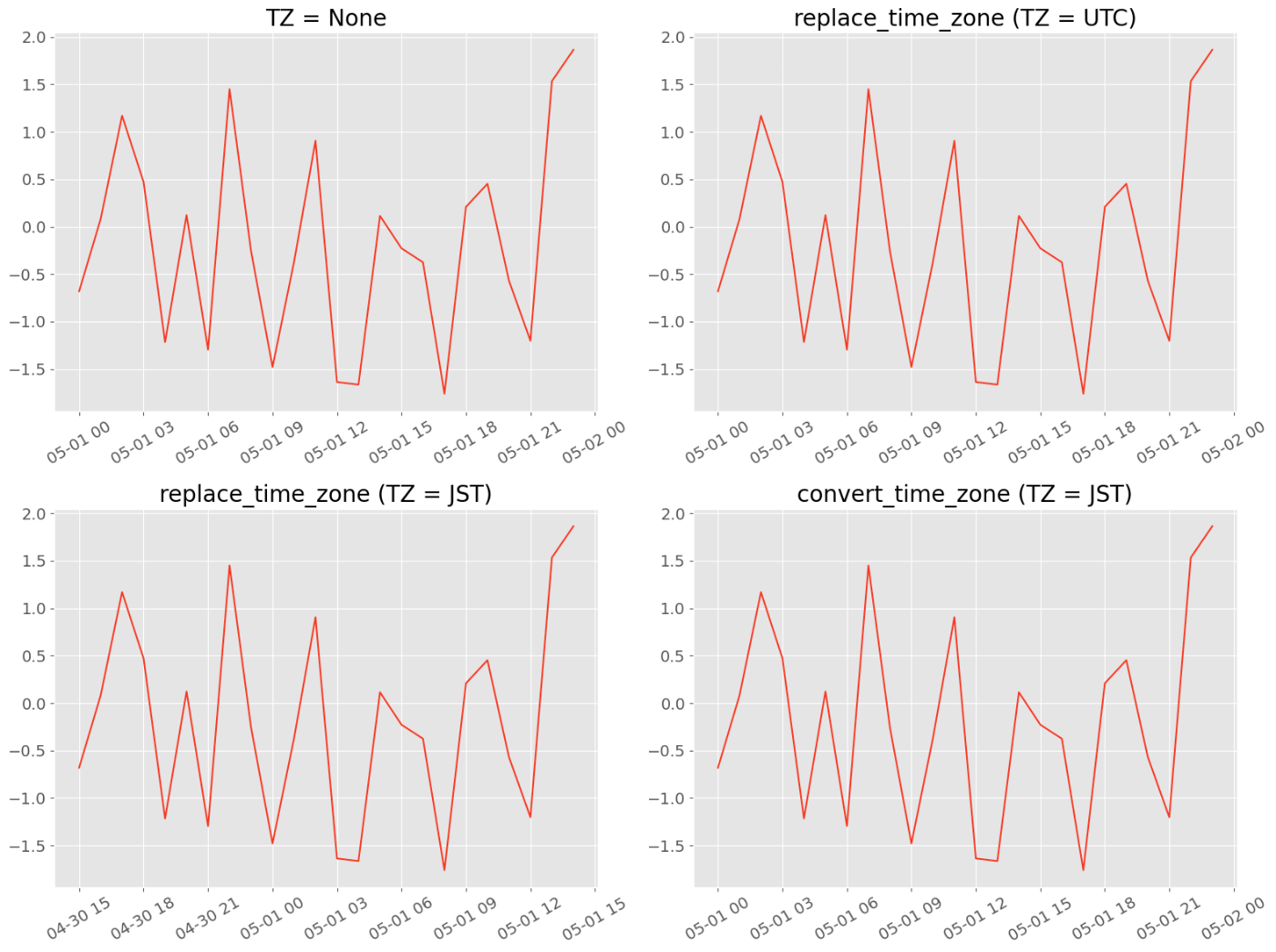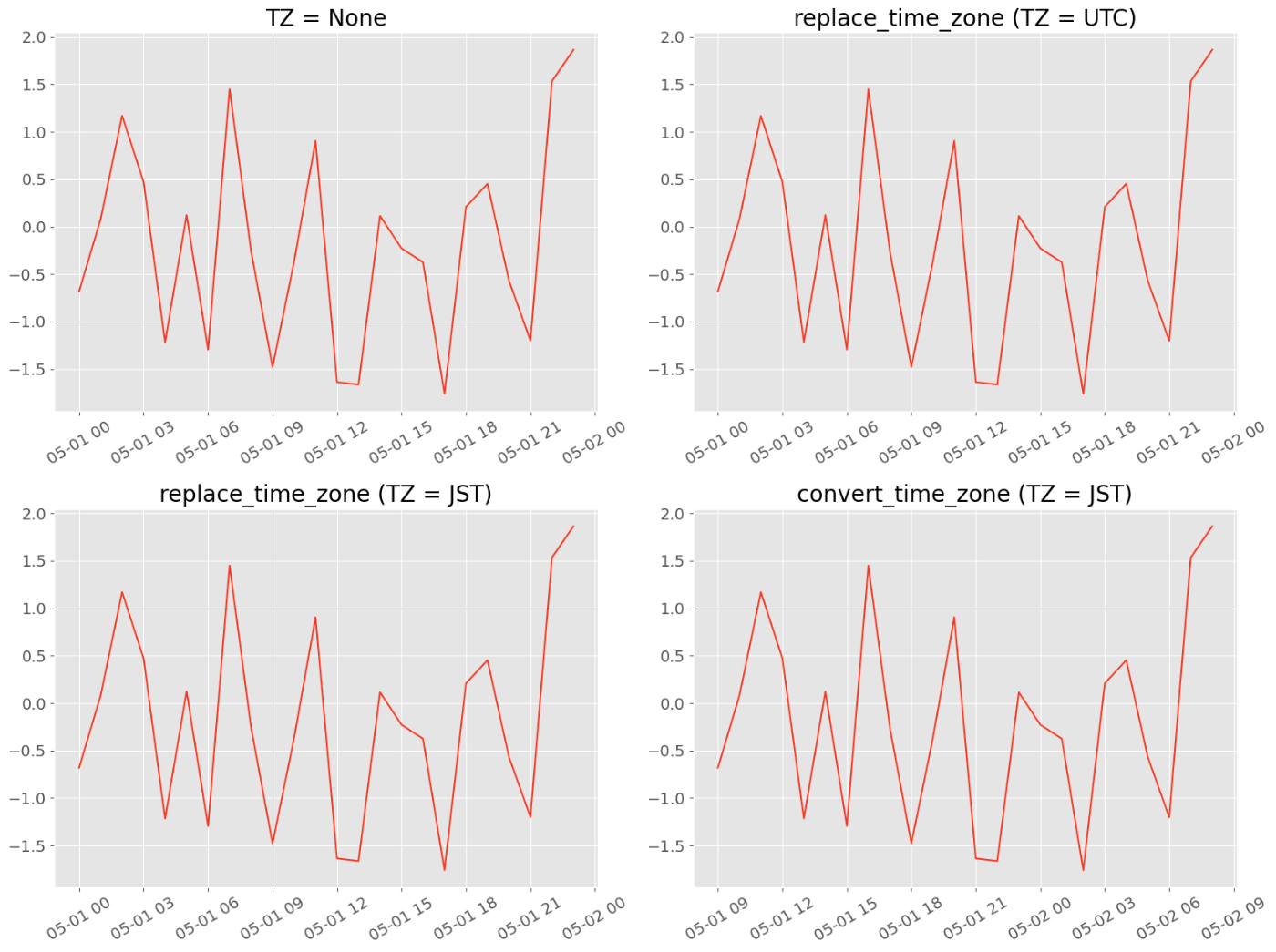Closed7
Polars の datetime Series を Matplotlib に渡すとタイムゾーンがおかしくなる?
バージョン確認
--------Version info---------
Polars: 0.17.13
Index type: UInt32
Platform: macOS-13.0-arm64-arm-64bit
Python: 3.11.2 (main, Apr 4 2023, 11:04:50) [Clang 14.0.0 (clang-1400.0.29.202)]
----Optional dependencies----
numpy: 1.24.3
pandas: 2.0.1
pyarrow: 12.0.0
connectorx: <not installed>
deltalake: <not installed>
fsspec: <not installed>
matplotlib: 3.7.1
xlsx2csv: <not installed>
xlsxwriter: <not installed>
適当に時系列データの DataFrame を作成
df = pl.DataFrame({
"timestamp": [datetime(2023, 5, 1, h, 0, 0) for h in range(24)],
"x": [np.random.randn() for _ in range(24)]
})
print(df.head())
┌─────────────────────┬───────────┐
│ timestamp ┆ x │
│ --- ┆ --- │
│ datetime[μs] ┆ f64 │
╞═════════════════════╪═══════════╡
│ 2023-05-01 00:00:00 ┆ -1.540741 │
│ 2023-05-01 01:00:00 ┆ 0.129755 │
│ 2023-05-01 02:00:00 ┆ 0.170982 │
│ 2023-05-01 03:00:00 ┆ 2.257728 │
│ 2023-05-01 04:00:00 ┆ 2.551089 │
└─────────────────────┴───────────┘
https://github.com/pola-rs/polars/issues/6767 の提案で、タイムゾーンの処理用メソッドがリネーム
- with_time_zone → convert_time_zone
- cast_time_zone → replace_time_zone
convert_time_zone は、UTC の時刻は保ったまま、指定のタイムゾーンの日時に変換する
例:2023-05-01T10:00+00:00 → 2023-05-01T19:00+09:00
一方、replace_time_zone は、タイムゾーンを設定するメソッド。 UTC から見ると、変換後はタイムゾーンの時差分だけ時刻が変化する。
例:2023-05-01T10:00+00:00 → 2023-05-01T10:00+09:00 (2023-05-01T01:00+00:00)
df = df.with_columns([
pl.col("timestamp")
.dt.replace_time_zone("UTC")
.alias("replace_timestamp_utc"),
pl.col("timestamp")
.dt.replace_time_zone("Asia/Tokyo")
.alias("replace_timestamp_jst"),
]).with_columns(
pl.col("replace_timestamp_utc")
.dt.convert_time_zone("Asia/Tokyo")
.alias("convert_timestamp_jst")
)
print(df.head())
┌──────────────┬───────────┬───────────────────────┬───────────────────────┬───────────────────────┐
│ timestamp ┆ x ┆ replace_timestamp_utc ┆ replace_timestamp_jst ┆ convert_timestamp_jst │
│ --- ┆ --- ┆ --- ┆ --- ┆ --- │
│ datetime[μs] ┆ f64 ┆ datetime[μs, UTC] ┆ datetime[μs, ┆ datetime[μs, │
│ ┆ ┆ ┆ Asia/Tokyo] ┆ Asia/Tokyo] │
╞══════════════╪═══════════╪═══════════════════════╪═══════════════════════╪═══════════════════════╡
│ 2023-05-01 ┆ -1.540741 ┆ 2023-05-01 00:00:00 ┆ 2023-05-01 00:00:00 ┆ 2023-05-01 09:00:00 │
│ 00:00:00 ┆ ┆ UTC ┆ JST ┆ JST │
│ 2023-05-01 ┆ 0.129755 ┆ 2023-05-01 01:00:00 ┆ 2023-05-01 01:00:00 ┆ 2023-05-01 10:00:00 │
│ 01:00:00 ┆ ┆ UTC ┆ JST ┆ JST │
│ 2023-05-01 ┆ 0.170982 ┆ 2023-05-01 02:00:00 ┆ 2023-05-01 02:00:00 ┆ 2023-05-01 11:00:00 │
│ 02:00:00 ┆ ┆ UTC ┆ JST ┆ JST │
│ 2023-05-01 ┆ 2.257728 ┆ 2023-05-01 03:00:00 ┆ 2023-05-01 03:00:00 ┆ 2023-05-01 12:00:00 │
│ 03:00:00 ┆ ┆ UTC ┆ JST ┆ JST │
│ 2023-05-01 ┆ 2.551089 ┆ 2023-05-01 04:00:00 ┆ 2023-05-01 04:00:00 ┆ 2023-05-01 13:00:00 │
│ 04:00:00 ┆ ┆ UTC ┆ JST ┆ JST │
└──────────────┴───────────┴───────────────────────┴───────────────────────┴───────────────────────┘
print する限りは、想定通りのタイムゾーンと日時になっているように見える。
グラフを作ってみる
fig = plt.figure()
ax1 = fig.add_subplot(2, 2, 1)
ax2 = fig.add_subplot(2, 2, 2)
ax3 = fig.add_subplot(2, 2, 3)
ax4 = fig.add_subplot(2, 2, 4)
ax1.plot(df["timestamp"], df["x"])
ax1.set_title("TZ = None")
ax2.plot(df["replace_timestamp_utc"], df["x"])
ax2.set_title("replace_time_zone (TZ = UTC)")
ax3.plot(df["replace_timestamp_jst"], df["x"])
ax3.set_title("replace_time_zone (TZ = JST)")
ax4.plot(df["convert_timestamp_jst"], df["x"])
ax4.set_title("convert_time_zone (TZ = JST)")
ax1.xaxis.set_tick_params(rotation=30)
ax2.xaxis.set_tick_params(rotation=30)
ax3.xaxis.set_tick_params(rotation=30)
ax4.xaxis.set_tick_params(rotation=30)
plt.tight_layout()

X 軸のラベルの値が、JST に変換したものも含め UTC の時刻で表示されてしまっている
現状の解決方法
Polars の Series を、to_list メソッドを使ってPython リストに変換してから plot に渡してあげれば JST で表示される
fig = plt.figure()
ax1 = fig.add_subplot(2, 2, 1)
ax2 = fig.add_subplot(2, 2, 2)
ax3 = fig.add_subplot(2, 2, 3)
ax4 = fig.add_subplot(2, 2, 4)
ax1.plot(df["timestamp"].to_list(), df["x"])
ax1.set_title("TZ = None")
ax2.plot(df["replace_timestamp_utc"].to_list(), df["x"])
ax2.set_title("replace_time_zone (TZ = UTC)")
ax3.plot(df["replace_timestamp_jst"].to_list(), df["x"])
ax3.set_title("replace_time_zone (TZ = JST)")
ax4.plot(df["convert_timestamp_jst"].to_list(), df["x"])
ax4.set_title("convert_time_zone (TZ = JST)")
ax1.xaxis.set_tick_params(rotation=30)
ax2.xaxis.set_tick_params(rotation=30)
ax3.xaxis.set_tick_params(rotation=30)
ax4.xaxis.set_tick_params(rotation=30)
plt.tight_layout()

datetime Series のタイムゾーンまわりの話題はちょこちょこあるっぽい
このスクラップは2023/08/16にクローズされました